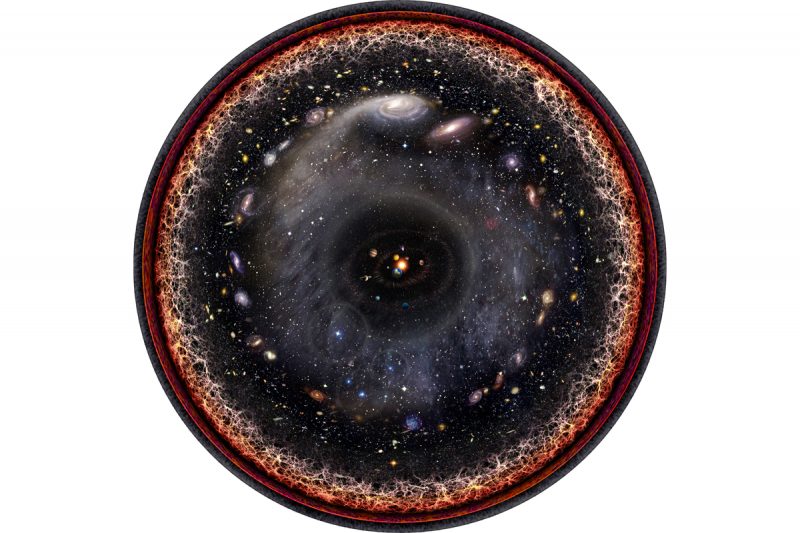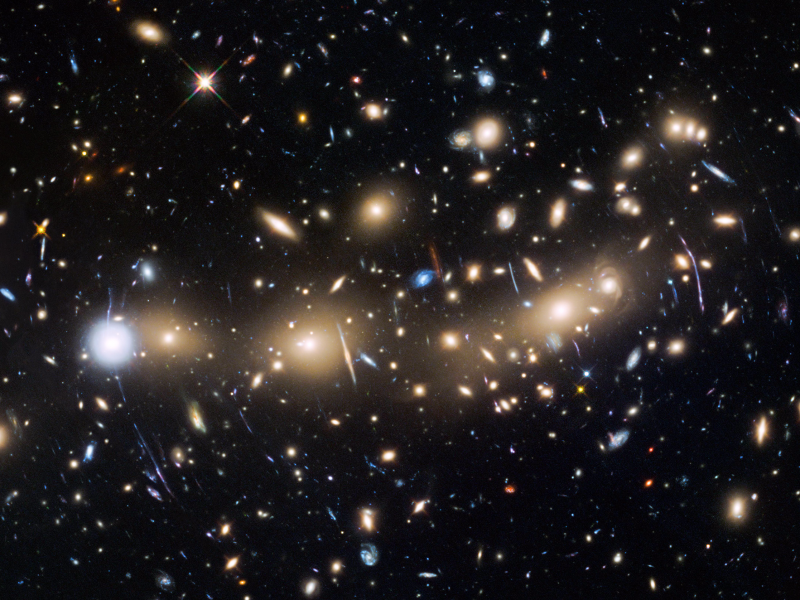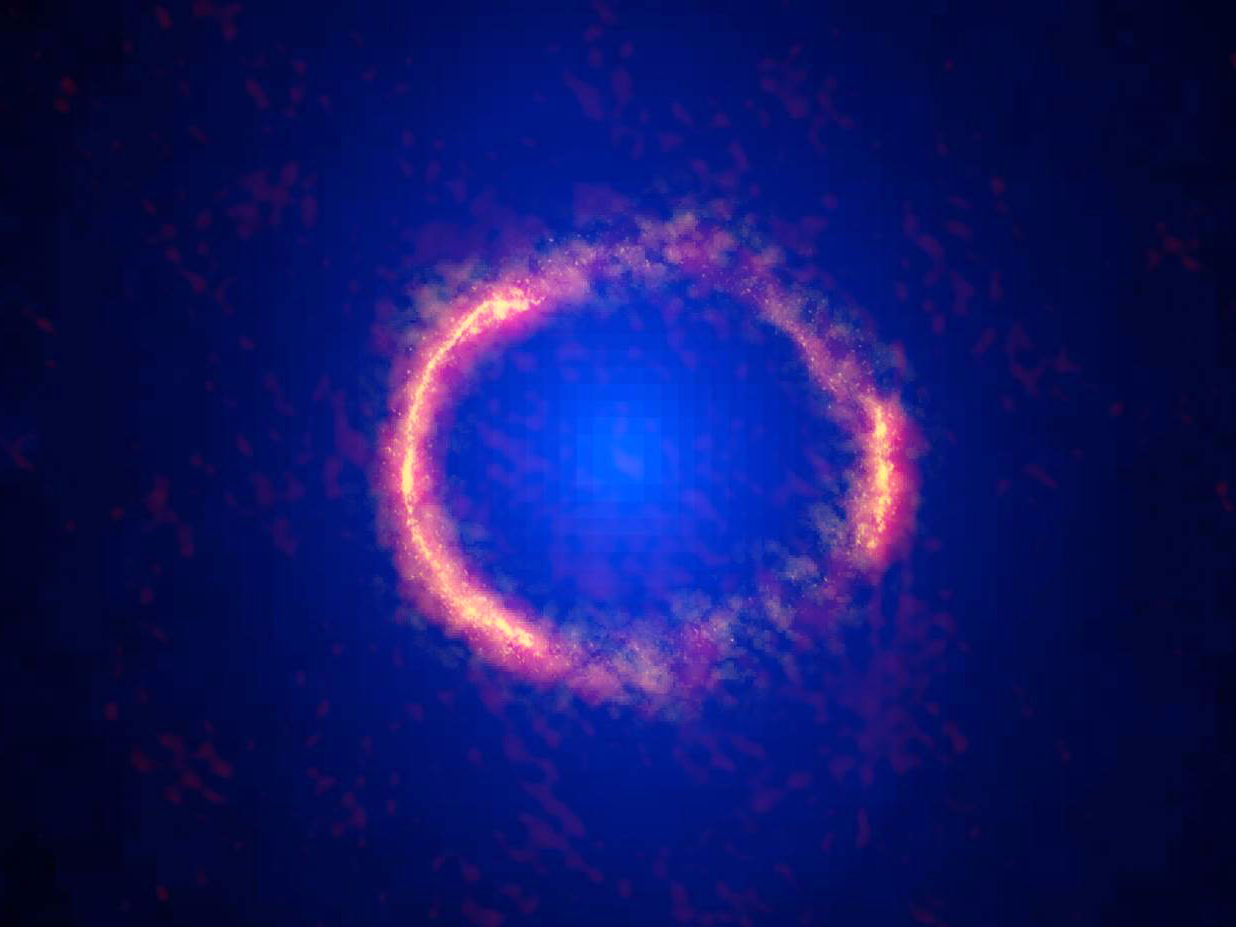Albert Einstein’s general theory of relativity predicts so much about the universe at large, including the existence of gravitational lenses or “Einstein rings.”
And yet his famous equations struggle to fully explain such objects.
While general relativity says a strong source of gravity – like the sun – will warp the fabric of space, bend light from a distant object, and magnify it to an observer, very big objects like galaxies and galaxy clusters make gravitational lenses that are theoretically too strong (like the one above). General relativity also can’t fully explain the spinning motions of galaxies and their stars.
That’s why most physicists think as much as 80% of the mass in the universe is dark matter: invisible mass that hangs out at the edges of galaxies. Dark matter might be made of hard-to-detect particles, or perhaps an unfathomable number of tiny black holes. But we have yet to find smoking-gun evidence of either.
However, a contentious theory by Erik Verlinde at the University of Amsterdam suggests dark matter may not be matter at all. What's more, astronomers say his idea "is remarkable" in its ability to explain the behavior of more than 33,000 galaxies that they studied.
"This does not mean we can completely exclude dark matter, because there are still many observations that Verlinde's theory cannot yet explain," study leader and physicist Margot Brouwer said in a YouTube video about the research. "However it is a very exciting and promising first step."
A new theory of gravity?

Called "emergent gravity," or EG, Verlinde's idea was first widely publicized by the New York Times in 2010. However, it took him 6 years to further his ideas into a more testable (though not-yet-peer-reviewed) study published on arXiv in November 2016.
Emergent gravity borrows from the very tiny (and very weird) world of quantum mechanics. It claims that gravity is really a "dark" gravitational force, one more like a natural side effect of the fabric of space than a field (like magnetism).
You might think of it as the outcome of a spacetime tug-of-war.
On the one hand, matter locally warps the fabric of space. On the other, a powerful and as-yet-unexplained force of nature, called "dark energy," is speeding up the expansion of space and the edge of the universe in all directions. (But don't worry, we may not go through a "big rip" until at least 2.8 billion years from now.)
Verlinde suggests the fabric of space has a kind of "elastic memory" for when visible matter pulls in space against expansion, "which can only relax very slowly", he wrote in his recent paper. With very large pockets of matter, that recoil generates his "dark" gravitational force at large distances.
Put another way, gravity may just be nature trying to fill a void with chaos, much like air rushing to fill a vacuum, or the heat of your body escaping into the space around you - no exotic, invisible, force-carrying particles required.
"In our view this undercuts the common assumption that the laws of gravity should stay as they are, and hence it removes the rationale of the dark matter hypothesis," Verlinde says. "Indeed, we have argued that the observed dark matter phenomena are a remnant, a memory effect, of the emergence of spacetime together with the ordinary matter in it."
If you're feeling confused by all this, you're not alone: Dennis Overbye wrote for the New York Times in 2010 that "[s]ome of the best physicists in the world say they don't understand Dr. Verlinde's paper, and many are outright skeptical."
However, a team of astronomers recently ran Verlinde's equations through a limited test - and they appeared to check out.
Emergent gravity clears its first hurdle

Brouwer and her colleagues tested emergent gravity by studying warped space around 33,613 galaxies.
Specifically, they looked at gravitational lenses caused by the galaxies, and how the background objects behind them were distorted.
"These bent images allow us to reconstruct the gravitational force around foreground galaxies up to a distance that is 100 times larger than the galaxies themselves," Brouwer said of her team's research, which was published December 11 in the British journal Monthly Notices of the Royal Astronomical Society.
"Usually we explain this gravity by assuming that each galaxy has a dark matter cloud of a certain mass," she said. "This time we also compared our data to the new theory of gravity by Erik Verlinde."
Brouwer said Verlinde's equations could explain gravity's distribution "without introducing any free parameters or invisible particles." Translation: No dark matter required.
But the 22 authors of that study (none of whom include Verlinde) are careful to point out that dark matter is far from a dead idea.
"Although [emergent gravity's] performance is remarkable, this study is only a first step," they wrote. "Further advancements on both the theoretical framework and observational tests of EG are needed before it can be considered a fully developed and solidly tested theory."
Timothy Brandt, an astrophysicist at the Institute for Advanced Study who's studied dark matter (but wasn't involved in any research noted here), told Business Insider in an email that - new evidence aside - Verlinde's concept leaves him with more questions than answers.
Brandt wondered, for example, if emergent gravity can also explain "the LIGO results, which perfectly match [general relativity]," evidence of the "dark matter content of dwarf galaxies," and the leftover energy of the universe's formation, called the cosmic background radiation.
Given this and other evidence for general relativity, Brandt said he "would bet pretty heavily against" emergent gravity replacing Einstein's theory.
But even if Verlinde's idea fails future tests, physics still needs to find a way to solve its biggest crisis: how to unite general relativity (the physics of the very big) with quantum mechanics (the physics of the very small) into a so-called "theory of everything."
"At large scales, it seems, gravity just doesn't behave the way Einstein's theory predicts," Verlinde told Astronomy Now in November.

